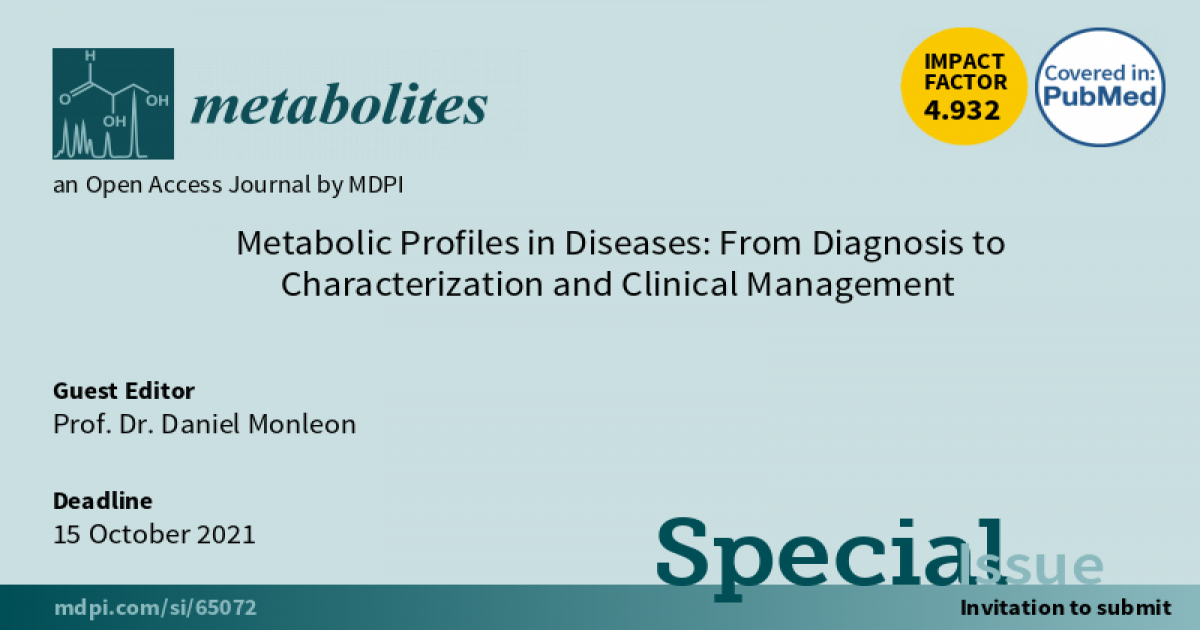Metabolic Profiles in Diseases: From Diagnosis to Characterization and Clinical Management
A special issue of Metabolites (ISSN 2218-1989). This special issue belongs to the section "Integrative Metabolomics".
Deadline for manuscript submissions: closed (15 April 2022) | Viewed by 20220

Special Issue Editor
Interests: tumor metabolism for precision medicine in cancer; healthy aging; frailty and metabolic age; host- microbiota co-metabolism influence on health; cardiometabolic and cardiovascular disease; biophysical characterization of lipoproteins particles in plasma using NMR spectroscopy
Special Issues, Collections and Topics in MDPI journals
Special Issue Information
Dear Colleagues,
Metabolomics, an experimental approach that provides information on a wide range of molecular processes, is gaining more and more importance in the clinical and pharmaceutical fields. The metabolome is closely linked to phenotype and constitutes an extremely useful tool for diagnosing diseases and evaluating the effects of treatments. The clinical applications of metabolomics in the different therapeutic areas include, among others, the diagnosis and prognosis of diseases, the stratification of patients for the application of personalized therapies, the prediction of responses to therapeutic interventions, the monitoring of patients throughout treatment and/or the course of a disease, the detection of relapses/reappearances of the disease, etc. This Special Issue of Metabolites, “Metabolic Profiles in Diseases: From Diagnosis to Characterization and Clinical Management”, will be dedicated to metabolomic studies dealing with the potential clinical applications of metabolomics. Specific areas include the identification of disease biomarkers, tools for patient follow up, predictive models, technological developments for bringing the field from the lab bench to bedside, etc. Manuscripts dealing with other pertinent challenging issues are also highly desired.
Prof. Dr. Daniel Monleon
Guest Editor
Manuscript Submission Information
Manuscripts should be submitted online at www.mdpi.com by registering and logging in to this website. Once you are registered, click here to go to the submission form. Manuscripts can be submitted until the deadline. All submissions that pass pre-check are peer-reviewed. Accepted papers will be published continuously in the journal (as soon as accepted) and will be listed together on the special issue website. Research articles, review articles as well as short communications are invited. For planned papers, a title and short abstract (about 250 words) can be sent to the Editorial Office for assessment.
Submitted manuscripts should not have been published previously, nor be under consideration for publication elsewhere (except conference proceedings papers). All manuscripts are thoroughly refereed through a single-blind peer-review process. A guide for authors and other relevant information for submission of manuscripts is available on the Instructions for Authors page. Metabolites is an international peer-reviewed open access monthly journal published by MDPI.
Please visit the Instructions for Authors page before submitting a manuscript. The Article Processing Charge (APC) for publication in this open access journal is 2700 CHF (Swiss Francs). Submitted papers should be well formatted and use good English. Authors may use MDPI's English editing service prior to publication or during author revisions.
Keywords
- Biomarkers
- Metabolism and disease
- Clinical applications
- Translational metabolomics
Benefits of Publishing in a Special Issue
- Ease of navigation: Grouping papers by topic helps scholars navigate broad scope journals more efficiently.
- Greater discoverability: Special Issues support the reach and impact of scientific research. Articles in Special Issues are more discoverable and cited more frequently.
- Expansion of research network: Special Issues facilitate connections among authors, fostering scientific collaborations.
- External promotion: Articles in Special Issues are often promoted through the journal's social media, increasing their visibility.
- Reprint: MDPI Books provides the opportunity to republish successful Special Issues in book format, both online and in print.
Further information on MDPI's Special Issue policies can be found here.






